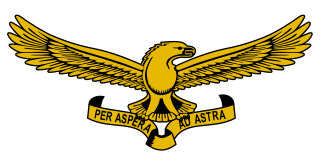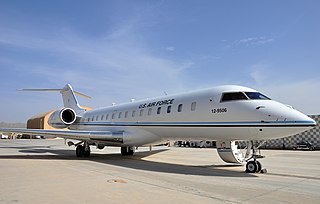Related Research Articles
Automatic Link Establishment, commonly known as ALE, is the worldwide de facto standard for digitally initiating and sustaining HF radio communications. ALE is a feature in an HF communications radio transceiver system that enables the radio station to make contact, or initiate a circuit, between itself and another HF radio station or network of stations. The purpose is to provide a reliable rapid method of calling and connecting during constantly changing HF ionospheric propagation, reception interference, and shared spectrum use of busy or congested HF channels.

The Defense Information Systems Agency (DISA), known as the Defense Communications Agency (DCA) until 1991, is a United States Department of Defense (DoD) combat support agency composed of military, federal civilians, and contractors. DISA provides information technology (IT) and communications support to the President, Vice President, Secretary of Defense, the military services, the combatant commands, and any individual or system contributing to the defense of the United States.
In NATO, a standardization agreement defines processes, procedures, terms, and conditions for common military or technical procedures or equipment between the member countries of the alliance. Each NATO state ratifies a STANAG and implements it within its own military. The purpose is to provide common operational and administrative procedures and logistics, so one member nation's military may use the stores and support of another member's military. STANAGs also form the basis for technical interoperability between a wide variety of communication and information systems (CIS) essential for NATO and Allied operations. The Allied Data Publication 34 (ADatP-34) NATO Interoperability Standards and Profiles which is covered by STANAG 5524, maintains a catalogue of relevant information and communication technology standards.

The South African Air Force (SAAF) is the air warfare branch of South African National Defence Force, with its headquarters in Pretoria. The South African Air Force was established on 1 February 1920. The Air Force saw service in World War II and the Korean War. From 1966, the SAAF was involved in providing infantry support in the low-intensity Border War in Angola, South-West Africa and Rhodesia. As the war progressed, the intensity of air operations increased, until in the late 1980s when the SAAF were compelled to fly fighter missions against Angolan aircraft in order to maintain tactical air superiority. On conclusion of the Border War in 1990, aircraft numbers were severely reduced due to economic pressures as well as the cessation of hostilities with neighbouring states.

The South African Army is the principal land warfare force of South Africa, a part of the South African National Defence Force (SANDF), along with the South African Air Force, South African Navy and South African Military Health Service. The Army is commanded by the Chief of the Army, who is subordinate to the Chief of the SANDF.

The South African National Defence Force (SANDF) comprises the armed forces of South Africa. The commander of the SANDF is appointed by the President of South Africa from one of the armed services. They are in turn accountable to the Minister of Defence and Military Veterans of the Defence Department.

Z-Wave is a wireless communications protocol used primarily for residential and commercial building automation. It is a mesh network using low-energy radio waves to communicate from device to device, allowing for wireless control of smart home devices, such as smart lights, security systems, thermostats, sensors, smart door locks, and garage door openers. The Z-Wave brand and technology are owned by Silicon Labs. Over 300 companies involved in this technology are gathered within the Z-Wave Alliance.

1 South African Tank Regiment is an armoured regiment of the South African Army, based at the Tempe military base in Bloemfontein as part of the South African Army Armour Formation.

The Battlefield Airborne Communications Node (BACN) is a United States Air Force (USAF) airborne communications relay and gateway system carried by the unmanned EQ-4B and the manned Bombardier E-11A aircraft. BACN enables real-time information flow across the battlespace between similar and dissimilar tactical data link and voice systems through relay, bridging, and data translation in line-of-sight and beyond-line-of-sight situations. Its ability to translate between dissimilar communications systems allows them to interoperate without modification.
An Airborne Network (AN) is the infrastructure owned by the United States Air Force that provides communication transport services through at least one node that is on a platform capable of flight.

The Heroine class are a variant of the Type 209 diesel-electric attack submarine developed by Howaldtswerke-Deutsche Werft (HDW) of Germany, currently in service with the South African Navy. The class is composed of three vessels.

PM WIN-T is a component of Program Executive Office Command, Control and Communications-Tactical in the United States Army. PM WIN-T has been absorbed into PM Tactical Networks as Product Manager for Mission Networks.

46 South African Brigade was established on April 1, 1999, as part of the restructuring process of the South African Army. Its initial function was to provide a formation headquarters for deployed reserve force elements and support 43 SA Brigade. 46 SA Brigade is a composite brigade consisting of a headquarters in Kensington, Johannesburg and a Brigade Administrative Area at Wallmansthal.
The Standard Interface for Multiple Platform Link Evaluation (SIMPLE) is a military communications protocol defined in NATO's Standardization Agreement STANAG 5602.

8 South African Infantry Battalion is a mechanized infantry unit of the South African Army. The battalion is equipped with Ratel Infantry Fighting Vehicles (IFV) used for fast transport and combat mobility across rough ground. Support weapons for mechanized infantry are also provided with motorized transport, or are built directly into these IFVs, in order to keep pace with the IFVs in combat. The battalion was raised at Upington in the Northern Cape on 01 October 1973 as part of the South African Infantry Corps, and since the change in structure, has been assigned to the Infantry Formation.

Eastern Province Command was a command of the South African Army.

The Joint Deployable Analysis Team (JDAT) is part of the J6 Directorate of the Joint Chiefs of Staff.
References
- ↑ "Fact file: Link ZA". defenceWeb. 18 January 2010. Retrieved 26 July 2014.
- ↑ de Silva, Richard (15 March 2012). "South Africa joins the TDL club". Defenceiq.com. Retrieved 26 July 2014.
- ↑ "LINKZA". Reutechcomms.com. 26 September 2013. Retrieved 26 July 2014.
Further sources
- Smith, Corné J.; Venter, Jacobus P. (November 2011). "A Case Study of the Development of a SANDF Tactical Data Link Network Enabling Capability" (PDF). Journal of Battlefield Technology. 14 (3). Argos Press. ISSN 1440-5113. OCLC 761453648.
- van Niekerk, Brett. "Interoperability in CNO and EW: Considerations for the African Continent" (PDF). School of Information Systems and Technology - University of KwaZulu-Natal . Retrieved 2 August 2014.
- Duvenhage, Arno; Terblanche, Luther. "The Evolution of a C2 Protocol Gateway" (PDF). Pretoria: Council for Scientific and Industrial Research . Retrieved 2 August 2014.
- Engelbrecht, Leon (12 May 2012). "Movement with Radiate?". defenceWeb. Retrieved 2 August 2014.
- Nel, J. J.; le Roux, W. H.; van der Schyf, O.; Mostert, M. (2007). Modelling Joint Air Defence Doctrinal Issues with a LinkZA-based Integration of two C2 Simulators – A Case Study (PDF). 2007 Military Information and Communications Symposium of South Africa (MICSSA) - 23-26 July 2007. CSIR Conference Centre, Pretoria, South Africa.
- Engelbrecht, Leon (28 November 2006). "SA should leverage advantage from military datalink". ITWeb. Retrieved 2 August 2014.